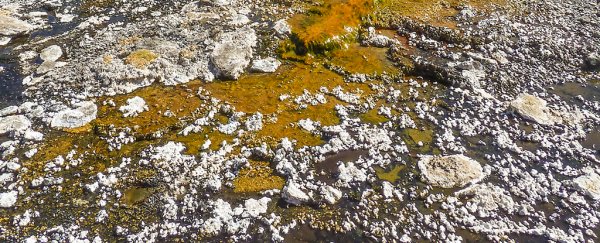Geologists working in northern Chile have found similarities between hot spring silica deposits on Earth and deposits photographed on Mars nine years ago – and they think they could be evidence of past life on the Red Planet.
These types of deposits on Earth typically contain microorganism fossils, and though NASA's Spirit rover couldn't look for evidence of life back in 2007, the research could prompt another rover visit to the Home Plate plateau on Mars.
The team from Arizona State University went looking for silica structures in El Tatio similar to those snapped on Mars, and say the closest matches were those produced by a combination of biological and non-biological processes – hot spring deposits created with the help of tiny organisms.
"The fact that microbes play a role in producing the distinctive silica structures at El Tatio raises the possibility that the Martian silica structures formed in a comparable manner," says one of the researchers, Steve Ruff. "In other words, with the help of organisms that were alive at the time."
The idea that hot springs had created the Home Plate deposits was raised when they were first photographed, but the findings in Chile give the hypothesis more credibility.
That's partly because the environment at El Tatio is so Mars-like: freezing temperatures at night, plenty of ultraviolet light from the Sun, and thin, dry air.
"Such conditions provide a better environmental analog for Mars than those of Yellowstone National Park (USA) and other well-known geothermal sites on Earth," write Ruff and his colleague Jack Farmer in Nature.
The researchers don't rule out the possibility that the silica deposits on Mars were created through non-biological processes, but they also say the fingerlike patterns in Chile are "among the most Mars-like of any silica deposits on Earth".
Based on what we know about Mars so far, it's likely that the only ancient fossils we're going to find will be microscopic ones. The problem is knowing where to look, which is where the new research can help.
If we want to take another pass at this part of Martian land, the next NASA rover to head to the Red Planet is due to launch in 2020. Unfortunately, Spirit was decommissioned in 2011 after getting stuck in soft soil.
Even then, we might need to return Martian rocks to laboratories on Earth before we can definitively say life once existed on the planet – but we're getting closer all the time.
NASA is still deciding where its 2020 rover should roam, but the Home Plate site is currently second on a list of eight possibilities, and Ruff and Farmer are backing its inclusion in the final list of four.
"This is a known hydrothermal deposit," says Ruff. "We know exactly where to land and where to go collect samples. And the silica structures found by Spirit meet the definition of a potential biosignature."
Spot the difference (Mars on the left, Chile on the right):
 Arizona State University
Arizona State University
